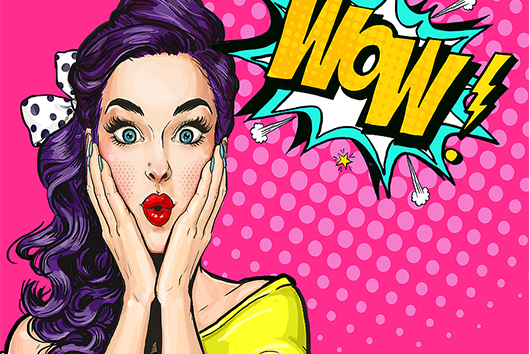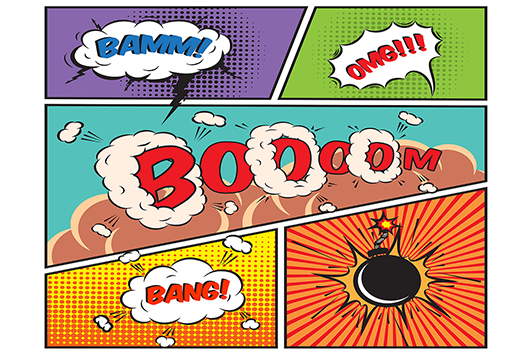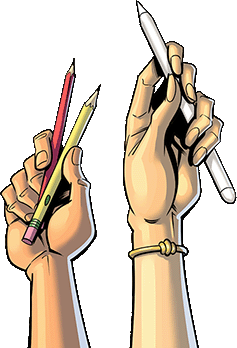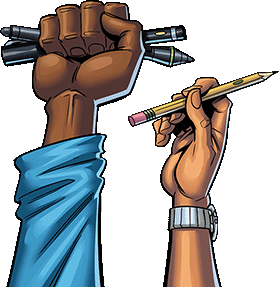What Are the 9 Essential Elements of Comic Book Design?
December 18, 2023
Comic book design is an adventure in storytelling and artistic expression. At its core, this creative process combines various elements of a comic book, including panels, dialogue, colors, and lettering, to create a captivating narrative.
Discover the key elements that form the foundation of a successful comic book, starting from brainstorming the story and developing characters in detail to building worlds that will thrill your readers.
Storyline
Like any good story, a comic book needs proper plot development, including narrative elements like exposition, rising action, climax, falling action, and resolution. To begin shaping your story, consider these strategies:
- Brainstorming. Begin by jotting down all ideas that come to mind, even if they seem silly or unconventional. This free-flowing method encourages creative thinking, allowing you to break free from creative blocks and discover novel approaches to storytelling.
- Mind mapping. Start with a central concept and branch out with related themes, characters, and plot points. This can help organize your thoughts and find connections between different ideas.
- The “What If?” technique. Pose hypothetical scenarios to yourself. For example, “What if humans could teleport?” or “What if AI ran the world?” These questions can spark imaginative and original storylines.
- Adapting real-life experiences. Draw inspiration from your own experiences or historical events, such as World War II, the Civil Rights Movement, or the Space Race, to create compelling backdrops for your stories.
- Genre blending. Combine elements from different genres. For instance, mix science fiction with fantasy or romance with mystery. This can lead to fresh and unexpected storylines.
- Writing prompts. Use prompts to ignite your creativity. There are many resources available online that provide story starters or situational prompts to get your creativity flowing.
Character Design
Character development is an integral part of adding depth to your story. Characters should be distinctive and memorable, with visual designs that reflect their personalities and roles in the story.
To create compelling characters, start with their backstory. Understanding a character’s history, motivations, and desires provides depth and drives their actions within the story. Next, consider their physical appearance, ensuring it matches their personality and background. For instance, a brooding character might have darker, more imposing visuals, while a lighthearted one could have brighter, softer features.
Characters should grow and change in response to the story’s events, which adds to the narrative’s energy and keeps readers engaged. This evolution reflects their journey, making them not just a part of the story but the story itself.
Creating a profile for each person is an excellent way to start building your characters. Similar to baseball stat cards or a passport, these profiles should list basic information like name, age, and physical attributes alongside more introspective characteristics such as background, personality traits, motivations, and fears. Include their relationships, professions, skills, and hobbies to add depth.
Ensure you refer to these profiles regularly as you write and illustrate your comic. Keeping these profiles easily accessible helps you create well-rounded characters and maintains consistency throughout their development in your story. This is especially important if you plan to publish multiple issues using the same characters or similar story arcs.
Panel Layout
Panel layout in comic books is a critical element that dictates the flow and rhythm of the narrative. The arrangement and size of panels on a page, along with the space between them, known as gutters, influence the pacing and focus of the story.
Traditional layouts often use uniform, grid-like structures, providing clarity and a steady narrative pace. Unconventional layouts with varying panel sizes and shapes can emphasize action and urgency, guiding the reader’s eye in a specific sequence and highlighting key moments in the story.
Large panels can slow the narrative, allowing for detailed artwork and moments of reflection or impact. Smaller panels quicken the pace, ideal for rapid action or dialogue. The gutters play a subtle yet powerful role in timing; wider gutters can indicate a pause or a break in time, while narrower ones suggest a faster, more seamless progression of events.
Innovative layouts, like splash pages seen in Frank Miller’s The Dark Knight Returns or borderless panels like those in The Arrival by Shaun Tan, break away from conventional grids. These add visual interest and emphasize certain aspects of the story, like a character’s mental state or a shift in tone.
Dialogue
Comic book dialogue is critical for conveying your characters’ conversations, thoughts, and narrative information. Unlike prose, comic dialogue works in tandem with visuals, meaning they must be brief and impactful. Dialog must propel the story and convey the characters’ voices without overcrowding the art.
Effective comic dialogue often uses concise, punchy sentences that capture a character’s personality and mood. It’s about showing rather than telling; for instance, a character’s background or emotions can be revealed through speech patterns and word choices rather than direct explanations, which can bore readers. Slang, accents, and unique speech quirks can differentiate characters and add realism.
Balancing dialogue with silence is also key. Sometimes, what’s unsaid can be as powerful as spoken words, allowing the artwork to carry the narrative.
When writing dialogue, consider the rhythm and flow. Break up longer speeches into shorter balloons to maintain visual appeal and readability. Thought bubbles can be used for internal monologues, while external dialogue is typically contained within speech bubbles.
Perspective and Composition
Perspective and composition in comic book panels are essential tools for guiding the reader’s eye and adding depth to the storytelling. Effective use of these elements can create a sense of space and movement, making the story more immersive.
Perspective, the technique used to represent three-dimensional objects on a two-dimensional surface, helps establish a scene’s depth. Techniques like one-point, two-point, or three-point perspective can make a scene feel more realistic or dramatic, depending on the effect you want to achieve.
Composition involves the arrangement of visual elements within a panel. It dictates what the reader sees first and the path their eye follows. Strategic placement of characters and objects in the foreground, middle ground, and background layers can create a focus point and build a visual hierarchy. This layering also helps in conveying spatial relationships between characters and their environment.
The use of leading lines – whether a cityscape’s straight lines or a winding road – can direct the reader’s attention to specific parts of the panel. The balance between detailed and open spaces within a panel can also influence the pacing and mood of the story.

Line Work and Inking
Line work and inking are fundamental for defining a comic book’s visual style and mood. The quality of lines – their thickness, texture, and fluidity – can convey the atmosphere and emotion of the story. Fine, crisp lines can give a clean feel, suitable for high-tech or futuristic settings, while rough, uneven lines might be used to evoke a darker, more organic atmosphere.
The inking process of going over pencil sketches with ink enhances the clarity and impact of your visuals. It defines the artwork, emphasizing shadows, contours, and textures. Skilled inkers use varying line weights to create depth and perspective, making the images pop off the page. Solid blacks and cross-hatching techniques can add volume and a sense of lighting, contributing to the overall tone.
This collaboration between pencilers and inkers is what gives comic art its distinctive, multi-dimensional appearance.
Color Palette
The color palette in a comic book is a powerful storytelling tool, capable of setting the tone and mood and even symbolizing deeper themes. Choice of colors can evoke specific emotions - warm hues like reds and oranges can convey passion or anger, while cooler tones like blues and greens often create a calm or somber atmosphere.
Vibrant, saturated colors make a scene feel energetic and lively, whereas muted colors are used for a more subdued, realistic feel.
Colors also help to establish time and place. For instance, sepia tones suggest a historical setting, while neon colors might be used for a futuristic world. But remember to keep the color schemes consistent. This helps make the story more unified and engaging.
The symbolic use of color can add layers of meaning to the story. A recurring color might be tied to a specific character, emotion, or theme, creating a subtext that enriches the reader’s experience.
For example, in Watchmen by Alan Moore and Dave Gibbons, color is used symbolically, particularly the recurring yellow motif, like the blood-stained smiley badge representing corruption and moral ambiguity. The limited palette, favoring secondary colors, creates a mood of unease and complexity, expressing the novel's themes.
Lettering and Typography
The lettering and typography in your comic are essential for conveying dialogue, but they are also integral to the comic’s overall aesthetic and readability. The style of the text, from the font choice to the size and weight, can influence the tone and mood of the story. For instance, bold, angular lettering might be used for intense action scenes, while a more flowing, elegant script is appropriate for romantic or contemplative moments.
Creative lettering can also be used to represent different characters’ voices. Unique fonts or colors for certain characters can help readers instantly recognize who is speaking, adding to character development. In Saga by Brian K. Vaughan and Fiona Staples, the characteristic fonts and speech bubble designs for different species underline the diversity of its universe.

Sound Effects
Sound effects in comics are a visual representation of auditory experiences, such as “BAM!” or “CRASH.” These onomatopoeic words add an auditory dimension to the visual narrative, making action scenes more interactive and engaging for the reader.
For instance, in The Amazing Spider-Man by Stan Lee and Steve Ditko, the iconic “THWIP” sound effect represents the moment when Spider-Man shoots his web, creating an auditory connection to the character’s web-swinging abilities.
To infuse your comic with powerful sound effects, harness the art of onomatopoeia. Strategically place words like “BOOM” or “SWOOSH” near the action, altering size and style to match the scene’s intensity.
Master the Elements of Comic Book Design and Bring Your Vision to Life With Comix Well Spring
When you’re ready to transform your creative vision into a tangible masterpiece, Comix Well Spring is here to assist you. Explore our range of customization options for binding and printing your comic. Whether you want a manga-style print or variant holographic covers, our straightforward ordering process ensures you’ll receive high-quality, professional-looking comics in no time.
Also, check out CWS Bookstore, where you can sell digital and printed versions of your comics without worrying about printing and order fulfillment. Contact Comix Well Spring to find out more about our services and for resources on how to create a comic book.


